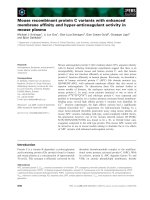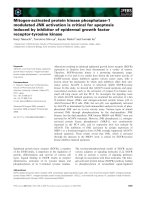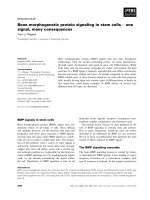báo cáo khoa học: " Nonhistone chromosomal protein patterns leucocytes of inbred chicken and their crosses" pptx
Bạn đang xem bản rút gọn của tài liệu. Xem và tải ngay bản đầy đủ của tài liệu tại đây (394.16 KB, 9 trang )
Nonhistone
chromosomal
protein
patterns
in
leucocytes
of
inbred
chicken
and
their
crosses
Sylvia
FRITSCHI
N.U.
BOSSHARD
G.
STRANZINGER
Federal
Institute
of
Technology
Institute
of
Animal
Production
Section
Animal
Breeding
CH-8092
Zurich,
Switzerland
Summary
The
patterns
of
nonhistone
chromosomal
proteins
(NHCP)
soluble
in
0.3
M
NaCI
of
pure
inbred
chicken
lines
and
their
crosses
have
been
analyzed.
Within
pure
bred
lines
there
is
little
variation
of
the
NHCP
patterns,
but
within
cross
and
between
different
pure
bred
lines
distinct
differences
can
be
detected.
Possible
practical
applications
of
the
analysis
of
NHCP
patterns
in
animal
production
are
discussed.
Key
words :
Nonhistones,
chicken,
leucocytes.
Résumé
Electrophorégrammes
de
protéines
chromosomiques
non
histoniques
(du
type
0.3
M
NaCI)
des
leucocytes
de
lignées
consanguines
et
de
leurs
croisements
chez
la
poule
Les
profils
électrophorétiques
de
protéines
(NHCP)
chromosomiques
non
histoniques
(du
type
0,3
M
NA
CI)
ont
été
établis
chez
la
poule
dans
des
lignées
consanguines
et
leurs
croisements.
Les
profils
NHCP
des
lignées
consanguines
elles-mêmes
varient
peu.
Cependant,
une
différence
très
nette
apparaît
pour
les
croisements
et
entre
les
différentes
lignées
consanguines.
Les
applications
pratiques
des
profils
électrophorétiques
sont
discutées
pour
la
production
animale.
Mots
clés :
Protéines
non
histoniques,
poulets,
leucocytes.
Present
address :
(*)
Institute
of
Toxicology,
Federal
Institute
of
Technology
and
University
of
Zurich,
CH-8603
Schwerzenbach,
Switzerland.
(’"
*)
Department
of
Pediatrics,
University
of
Zurich,
CH-8032
Zurich,
Switzerland.
I.
Introduction
Inbred
lines
are
a
useful
tool
in
animal
breeding
and
genetic
studies,
since
by
continuing
inbred
pairing
the
homozygosity
increases
from
one
generation
to
another.
We
have
chosen
inbred
chicken
lines
that
show
distincts
differences
in
genotype
(A
BPLANALP
et
al.,
1981),
phenotype
and
behaviour
to
study
patterns
of
nonhistone
chromosomal
proteins
(NHCP)
in
leucocytes.
Part
of
the
nonhistone
proteins
are
considered
to
be
involved
in
gene
regulation
(A
LLFREY
,
1974 ;
PAUL
&
G
IL
-
MOUR
,
1975 ;
C
HIU
&
H
NILICA
,
1977 ;
HoRST et
al.,
1981)
and
have
been
found
to
be
species-specific
(C
HIU
&
H
NILICA
,
1977 ;
B
OSSHARD
et
al.,
1982).
In
thymus
tissues
of
cattle,
differences
in
the
NHCP
patterns
have
been
found
between
individuals
of
the
same
breed
(B
OSSHARD
&
S
TRANZINGER
,
1983)
and
family
studies
of
cattle
suggest
that
NHCP
patterns
in
leucocytes
can
be used
as
genetic
markers
(B
OSSHARD
,
unpubl.
data).
NHCP
patterns
may
serve
for
the
biochemical
characterization
of
inbred
chicken
lines,
leading
eventually
to
correlation
of
certain
characteristics
in
the
NHCP
patterns
with
phenotypical
traits
of
the
animals.
II.
Material
and
methods
White
Leghorn
chicken
inbred
lines
71,
75,
77,
79
(H
AGGER
&
S
TEIGER
-S
TAFL
,
1982)
and
their
crosses
71
X
79,
71
X
75,
75
X
77
and
77
X
79
from
our
experimental
station
were
raised
and
kept
under
indenthal
conditions.
Blood
samples
(20-25
ml/
animal)
were
collected
from
the
wing
veins
of cocks.
To
avoid
coagulation,
the
needles
and
syringes
were
haprinized
(Heparin,
5000
!/ml,
Seromed,
Munich,
West
Germany).
The
samples
were
transported
on
ice
to
a
cold
room
(4
°C)
and
stored
overnight.
A.
Isolation
of
Leucocyte
Nuclear
Proteins
All
steps
of
protein
extraction
were
conducted
at
4
°C
in
the
cold
room.
Blood
samples
were
centrifuged
in
two
10
ml
portions
for
30
min
at
3,000
X
g
(Junior
3000,
Haereus
Christ,
Osterode,
West
Germany).
The
supernatant
was
removed
and
discarded.
The
leucocyte
fraction,
lying
on
top
of
the
erythrocyte
sediment,
was
collected
by
a
pipette,
washed
by
dispersing
it
in
10
ml
of
isotonic
NaCI-solution
(Isoton
II,
Coulter
Electronics
GmbH,
Krefeld,
West
Germany)
and
centrifuged
for
10
min
at
1,500
X
g.
The
sediment
was
dispersed
in
10
ml
of
150
mM
NH
4
C&dquo;
kept
in
this
solution
for
20
min
and
centrifuged
for
10
min
at
1,000
X
g.
This
procedure,
which
removes
erythrocytes
contamination
(B
OYLE
,
1968)
was
re-
peated
twice
exposing
the
cells
to
NH
4
CI
for
20
min
and
twice
fort
10
min.
Afterwards
the
sediment
was
dispersed
in
10
ml
of
solution
C
(80
mM
Nad,
20
mM
EDTA-Na
*,
adjusted
to
pH
8.0
with
1
M
Tris
*
),
two
drops
(ca.
50
!,1)
of
Zaponin
(Coulter
Electronics
Ltd,
Harpenden,
GB)
were
added
and,
after
shaking,
the
samples
were
kept
in
this
solution
for
two
min.
This
procedure
yielded
a
purified
leucocyte
nuclear
fraction.
After
ading
10
ml
of
solution
C
and
(*)
EDTA-Na
=
Ethylenediaminetetraacetic
acid
disodium
salt.
Tris
=
Tris
(hydroxymethyl)-aminomethane.
centrifuging
for
10
min
at
1,000
X
g,
the
Zaponin
was
washed
out
of
the
sediment
by
subsequently
resuspending
it
in
solution
C
and
then
in
120
mM
NaCl,
0.5
mM
EDTA-Na,
adjusted
to
pH
8.0
with
1
M
Tris,
and
centrifuging
for
10
min
each
at
1,000
X
g.
The
nuclei
were
then
dispersed
in
25
ml
of
300
mM
NaCI,
10
mM
Tris-
HCl
(pH
7.2),
0.25
mM
EDTA-Na
and
kept
on
a
magnetic
stirrer
for
60
min.
By
this
procedure
nonhistone
proteins
were
extracted
from
the
nuclei.
They
were
separated
from
the
remaining
nuclei
by
centrifugation
for
15
min
at
17,500
X
g
(junior
15000,
Haereus
Christ,
Osterode,
West-Germany).
The
supernatant,
containing
soluble
nuclear
proteins
(B
OSSH
A
RD
,
1979 ;
BO
SSHARD
&
S
TRANZINGER
,
1983)
was
dialyzed
four
times
against
20
to
50
times
its
volume
of
0.5
mM
EDTA-Na,
adjusted
to
pH
8.0
with
1
M
Tris,
for
at
least
8
hours,
centrifuged
for
15
min
at
17,500
X
g
and
the
supernatant
was
freeze-dried.
B.
Determination
of
DNA
and
Protein
Concentrations
DNA
and
protein
concentrations
were
determined
as
reported
previously
(B
OSSHARD
Bt
al.,
1982)
by
measuring
the
optical
density
(OD)
of
the
samples
at
250
nm
and
260
nm
with
a
Perkin
Elmer
550
spectrophotometer.
C.
Polyacrylamide
Gel
Electrophoresis
(PAGE)
Electrophoresis
in
7.5
p.
100
SDS
*
-polyacrylamide
gels
was
carried
out
according
to
procedures
of
L
AEMMLI
(1970)
in
vertical
slabs
1.5
mm
thick
in
a
Bio-Rad
220
chamber
(Bio-Rad,
Richmond,
CA,
USA).
The
lyophilized
samples
were
dissolved
in
sample
buffer
(SDS
1
p.
100,
urea
6
M,
mercaptoethanol
1
p.
100
(v/v),
NaH
2
P0
4
10
mM,
adjusted
to
pH
7.2
with
NaOH)
according
to
WEBER
&
Ossottrr
(1969)
at
a
concentration
of
2
mg
protein/ml.
Electrophoresis
at
220
V
(constant)
was
stopped
after
the
Bromphenol
Blue
marker
of
the
sample
had
reached
the
bottom
of
the
gel
(about
90
to
110
min).
The
gels
were
stained
overnight
in
a
solution
containing
0.025
p.
100
Coomassie
Blue
R-250,
50
p.
100
methanol
and
7
p.
100
acetic
acid,
destained
in
5
p.
100
methanol
with
7
p.
100
acetic
acid,
and
scanned
at
570
nm
with
a
densitometer
(Quick
Scan
Junior
TLC,
Desaga,
Heidelberg,
West
Germany).
Densitometric
scans
were
replotted
on
a
digitizer
HP
9874 A
(Hewlett
Packard,
Fort
Collins,
USA).
Areas
under
prechosen
sections
of
a
densitometric
scan
were
measured
and
expressed
as
percent
of
the
total
integral
by
a
desktop
computer
(HP
9845
B)
and
re-drawn
on
an
XY-plotter
(HP
9872
B).
III.
Results
A.
Reproducibility
of
the
NHCP
Extraction
Method
Blood
samples
of
the
same
cock
were
taken
3
times
at
intervals
of
one
week
and
NHCP’s
were
extracted
from
the
leucocytes
to
test
the
reproducibility
of
the
(’·)
SDS
=
Sodium
dodecyl
sulfate.
preparation
method
(fig.
1).
The
3
densitometer
scans
show
only
small
variations
in
relative
height
of
peaks
#
4,
6,
8,
and
11.
The
poor
congruence
of
the
fast
moving
proteins
is
partly
explained
by
different
running
speeds
of
the
samples.
Integrals
pf
the
areas
of
4
chosen
prominent
peaks
are
shown
in
table
1 ;
values
are
given
in
percent
of
the
total
integrals.
Electropherograms
of
3
independent
samples
of
the
same
cock
(inbred
line
71).
7.5
p.
100
SDS-PAGE,
start
left ;
#
4
to
11 :
Peak
.# ;
A :
Optical
density
O.
=
570
nm) ;
L :
Running
distance.
Electrophorégramme
de
3
échantillons
indépendants
d’un
même
coq
(lignée
consan-
guine
71).
,7,5
p.
100
SDS-PAGE,
start
gauche;
.#
4
à
11 ;
#
numéro
des
pics;
A :
Densité
optique
(X
=
570
nm) ;
L :
Distance
parcourue.
Comparison
of
different
inbred
lines
and
their
crosses
NHCP-electropherograms
of
the
2
inbred
lines
71,
75
and
the
cross
75
X
71
are
show
in
figure
2
(N
=
3
for
the
purebred
lines,
N
=
4
for
the
cross).
Peaks
#
4
and
6
are
smaller
in
line
71
than
in
line
75.
Peak
#
8
shows
high
values
in
both
purebred
lines
whereas
peak
#
11
is
high
in
line
71
and
low
in
line
75.
The
cross
71
X
75
values
cover
the
whole
range
between
values
of
lines
71
and
75
for
all
peaks
considered
above.
Four
pure
inbred
lines
were
examined
in
all.
The
values
for
the
integrated
peak
areas
from
inbred
lines
71, 75, 77,
and
79
and from
crosses
71
X
79,
71
X
75,
75
X
77,
77
X
79
are
given
in
figure
3,
wherein
the
data
of
figure
2
are
included.
The
most
perceivable
differences
in
peak
size
can
be
seen
in
peak
#
4,
where
line
77
shows
the
highest
values,
and
in
peak
#
11,
where
lines
71,
79,
71
X
79,
and
71
X
75
have
evidently
greater
peak
areas
than
the
others.
Although
the
range
of
variation
is
in
some
cases
rather
large,
the
mean
peak
sizes
of
the
crosses
are
mostly
between
the
values
of
the
inbred
lines
from
which
they
were
derived.
IV.
Discussion
Nonhistone
chromosomal
proteins
(NHCP)
form
a
heterogenous
group
of
proteins
with
diverse
biological
functions
such
as
enzymes,
proteins
affecting
chromatin
(and
chromosome)
structure
and
gene
regulation
(J
OHNSON
et
al.,
1974 ;
PAUL
&
G
ILMOUR
,
1975).
The
fact
that
NHCP’s
play
an
important
role
in
gene
activation
has
been
generally
accepted
(A
LLFREY
,
1974 ;
PAUL
&
G
ILMOUR
,
1975 ;
McGILLIVRAY,
1976 ;
C
HIU
&
H
NILICA
,
1977 ;
H
ORST
et
al.,
1981),
but
the
group
of
gene
regulating
NHCP’s
has
up
to
now
hardly
been
characterized.
The
large
number
of
nonhistone
proteins
found
in
different
tissues
and
species
may
be
responsible
for
this
lack
of
knowledge ;
in
addition
to
that
it
may
be
assumed
that
few
copies
of
a
protein
would
suffice
for
gene
regulating
activities
(M
CG
ILLIVRAY
,
1977),
making
it
doubtful
whether
they
would
be
detected
on
a
Coomassie
Blue
stained
gel.
On
the
other
hand
tissue
-
and
species
-
specific
differences
in
the
patterns
of
extracted
NHCP’s
do
occur
(C
HIU
&
H
NILICA
,
1977 ;
A
NACHK
O
VA
&
R
USSEV
.
1977 ;
B
OSSH
A
RD
et
al.,
1982),
therefore,
they
can
be
used
as
markers
of
a
given
genotype
and/or
state
of
gene
expression.
The
NHCP
patterns
of
chicken
leucocytes
of
4
inbred
lines
and
their
crosses
were
examined.
Within
inbred
lines
there
are
relatively
small
differences
of
the
protein
patterns
(expressed
as
protein
peak
numbers
and
sizes
of
electropherograms)
whereas
within
crosses
individual
peak
sizes
vary
mostly
within
the
boundaries
defined
by
their
parental
inbred
lines.
If
we
stipulate
that
the
NHCP
pattern
reflects
a
certain
state
of
gene
expression,
one
could
assume
that
this
pattern
can
be
influenced
by
environmental
factors.
Since
all
donor
animals
in
our
experiments
have
been
kept
under
identical
conditions,
the
environmental
influence
should
be
similar
on
all
animals
considered ;
in
fact
a
check
on
the
reproducibility
of
the
NHCP
extraction
method
and
on
a
possible
time-
influence
shows
that
the
pattern
of
one
individual
was
constant
over
a
period
of
3
weeks,
the
time
interval
in
which
all
the
samples
for
this
study
were
collected.
Hence,
differences
observed
in
the
NHCP
patterns
may
be
attributed
mainly
to
different
genotypes,
and
highly
inbred
lines
have
been
chosen
for
the
experiments
to
keep
variations
of
genotypes
within
a
given
line
on
a
low
level.
The
comparison
between
patterns
of
pure
inbred
lines
and
their
crosses
shows
that
some
peaks
(#
4,
6, 8,
11)
are
prominent
in
all
samples ;
they
may
be
characte-
ristic
for
some
cell
functions
of
leucocytes.
The
data
available
up
to
now
do
not
permit
any
correlation
between
certain
protein
bands
and
phenotypic
traits.
For
example,
lines
71
and
75
have
the
same
genetic
background
and
are
the
product
of
selection
for
high
egg
weight
(H
ILFIKER
-H
ENGARTNER
,
1967) ;
the
only
significant
difference
in
their
NHCP
patterns
is
the
size
of
peak
#
11.
On
the
other
hand,
this
peak
is
high,
too,
in
line
79,
which
originates
from
selection
for
low
egg
weight ;
hence,
any
correlation
of
the
size
of
peak
# 11
with
egg
weight
can
be
ruled
out
in
the
lines
concerned.
Whether
correlations
between
NHCP
patterns
of
leucocytes
and
phenotypical
traits
such
as
egg
weight
are
at
all
to
be
expected
is
a
point
open
to
argumentation,
but
we
have
shown
that
the
NHCP
patterns
can
be
used
as
markers
for
the
genetic
status
of
any
individual
or
inbred
line.
Such
markers,
which
are
quickly
established,
might
be
useful
in
animal
production
for
checking
the
homo-
geneity
of
an
inbred
line,
the
association
of
an
individual
of
unknown
origin
to
a
certain
breed
or
family,
and,
possibly,
for
the
detection
of
bearers
of
congenital
diseases.
Since
most
of
the
biochemical
markers
presently
explored
have
not
shown
any
linkage
to
economically
relevant
traits
of
farm
animals,
new
markers
such
as
NHCP’s
could
be
useful
for
gene
mapping,
too.
Acknowledgements
The
authors
wish
to
thank
Dr.
C.
H
AGGER
and
Mrs.
D.
S
TEIGE
R-S
TA
FL
for
supplying
the
sample
materials
for
this
investigation.
Supported
by
ETH
grant
No.
0775/41-0735.5,
2461/41-0735.5.
Request
reprints
from
Prof.
Dr.
G.
S
TRANZINGER
,
Institut
fur
Tierproduktion,
Gruppe
Tierzucht,
ETH-Zentrum,
CH-8092
Ziirich
(Switzerland).
Received
March
5,
1984.
Accepted
October
26,
1984.
References
A
LLFREY
V.G.,
1974.
DNA-binding
proteins
and
transcriptional
control
in
procaryotic
and
eucaryotic
systems.
In :
C
AMERON
I.L.
&
J
ETER
J.R.
(eds),
Acidic
Proteins
of
the
Nucleus,
2-27.
Academic
Press,
New
York.
A
NACHKOVA
B.,
R
USSEV
G.,
1977.
Evidence
for
the
existence
of
a
fraction
of
rat
liver
chromatin
containing
only
a
few
specific
nonhistone
proteins
and
reduced
amount
of
histone
H
1.
FEBS
Lett.,
81,
37-38.
A
BPLANALP
H.,
H
AGGER
C.,
B
RILES
R.,
1981.
Genetic
variation
of
blood
groups
in
inbred
lines
of
Leghorns,
derived
from
a
common
base
population.
J.
Hered.,
72,
224-226.
B
OSSHARD
N.U.,
1979.
Einfluss
von
lonen
und
Nitchthiston-Proteinen
auf
den
strukturelle
Zustand
von
isoliertem
Kalbsthymus-Chromatin.
Dissertation,
Universitdt
des
Saarlandes,
Math Naturw.
Fak.,
SaarbrUcken,
West
Germany.
B
OSSHARD
N.U.,
M
OREL
P.,
S’r
RA
rrzINGER
G.,
1982.
Comparison
of
chromosomal
protein
patterns
of
thymus
and
liver
in
cattle,
sheep,
goats
and
pigs,
J.
Anim.
Sci.,
54,
248-257.
B
OSSHARD
N.U.,
S
TRANZINGER
G.,
1983.
Individual
patterns
of
thymus
nonhistone
chromosomal
proteins
in
cattle.
Z.
Tierz.
Ziichtgsbiol.,
100,
296-303.
B
OYLE
W.,
1968.
An
extension
of
the
51Cr-release
assay
for
the
estimation
of
mouse
cytotoxins.
Transplantation,
6,
761-764.
Cmu
J F.,
H
NILICA
L.S.,
1977.
Nuclear
nonhistone
proteins :
Chemistry
and
function.
In :
.’
Li
H.J.,
E
CKHARDT
R.A.
(eds),
Chromatin
and
Chromosome
Structure,
193-254.
Academic
Press,
New
York.
H
AGGER
C.,
S’r
EIGER
-S
TAFL
D.,
1982.
Befruchtungsrate
und
embryonale
Sterblichkeit
bei
hoch
ingeziichteten
Gefliigellinien
des
Typs
Weisse
Leghorn
in
Reinzucht
und
Kreuzung.
Schweiz.
Landwirtsch.
Monatshefte,
60,
269-275.
H
ILFIKER
-H
ENGARTNER
H.,
1967.
Die
Veranderung
der
Blutgruppenfrequenzen
im
Laufe
eines
Selektionsexperimentes
nach
Anfangseigewicht.
Z.
Tierz.
Ziichtgsbiol.,
84,
73-79.
H
ORST
A.,
R
AKOWICZ
-S
ZULCZYNSKA
E.M.,
WI
LAND
E.,
1981.
Non-histone
chromatin
proteins
during
various
stages
of
activity
of
immuno-competent
cells.
Mol.
Cell.
Biochem.,
37,
3-12.
Joa
N
SOrr
J.D.,
D
OUVAS
A.S.,
B
ONNER
J.,
1974.
Chromosomal
proteins.
Int.
Rev.
Cytol.,
Suppl.
4,
273-361.
L
AEMMLI
U.K.,
1970.
Cleavage
of
structural
proteins
during
the
assembly
of
the
head
of
bacteriophage
T.
4.
Nature,
227,
680-685.
MCG
ILLIVRAY
A.J.,
1976.
Non-histone
nuclear
proteins
as
gene
regulators ?
Biochem.
Soc.
Trans.,
4,
976-978.
MCG
ILLIVR
AY
A.J.,
1977.
The
analysis
of
chromatin
non-histone
proteins.
In :
B
RADBURY
E.M.,
J
AVAHERIAN
K.
(eds),
The
Organization
and
Expression
of
the
Eukaryotic
Genome,
21-41.
Academic
Press,
New
York.
PAUL
J.,
G
ILMOUR
R.S.,
1975.
The
regulatory
role
of
non-histone
proteins
in
RNA-synthesis.
In :
The
Structure
and
Function
of
Chromatin,
Ciba
Foundation
Symposium,
28
(new
series),
181-198.
Elsevier-Excerpta
Medica-North
Holland,
Amsterdam-Oxford-New
York.
WEBER
K.,
OssROrr
M.,
1969.
The
reliability
of
molecular
weight
determinations
by
dodecylsulfate-polyacrylamide
gel
electrophoresis.
J.
Biol.
Chem.,
244,
4406-4412.









